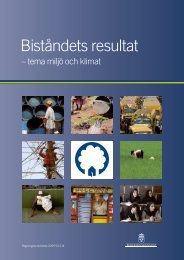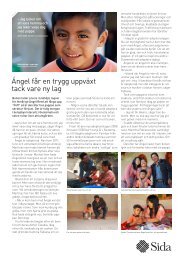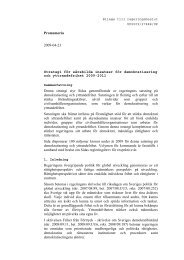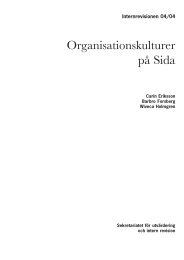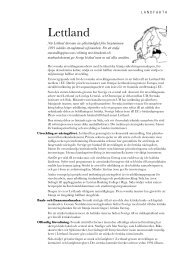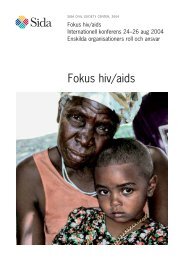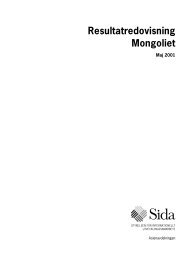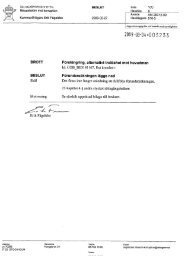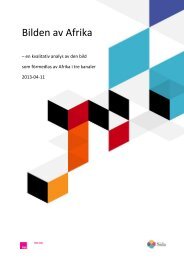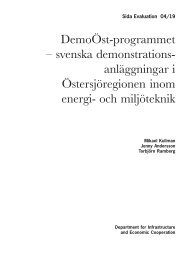Mobilisation of the Poor – a means to Poverty Reduction? - Sida
Mobilisation of the Poor – a means to Poverty Reduction? - Sida
Mobilisation of the Poor – a means to Poverty Reduction? - Sida
Create successful ePaper yourself
Turn your PDF publications into a flip-book with our unique Google optimized e-Paper software.
positive aspects <strong>of</strong> women’s empowerment, and indeed empowerment <strong>of</strong> households, is a reduction<br />
in incidents <strong>of</strong> violence against women, however modest that reduction may be.<br />
In <strong>the</strong> survey we also examined <strong>the</strong> effect <strong>of</strong> CAP on reducing substance abuse at <strong>the</strong> household<br />
level, as substance abuse by men <strong>of</strong>ten gives rise <strong>to</strong> additional problems for women. Of <strong>the</strong><br />
households that responded <strong>to</strong> this question, 45 per cent said that <strong>the</strong>re was some discussion on how<br />
<strong>to</strong> reduce consumption <strong>of</strong> alcohol and o<strong>the</strong>r substances at <strong>the</strong> household level. However, only 1.9<br />
per cent <strong>of</strong> households reported termination <strong>of</strong> substance use due <strong>to</strong> CAP interventions, while<br />
ano<strong>the</strong>r 11.3 per cent reported a decline in substance use due <strong>to</strong> <strong>the</strong> same interventions. On <strong>the</strong><br />
whole, <strong>the</strong>re has been only a limited change in intrahousehold gender relations as a result <strong>of</strong> CAP.<br />
Have women gained a voice via CAP?<br />
The field visits <strong>of</strong> <strong>the</strong> evaluation team and <strong>the</strong> discussions held with group members and <strong>of</strong>ficebearers<br />
in CAP organisations give an impression that group membership and a sense <strong>of</strong> community were<br />
important aspects <strong>of</strong> <strong>the</strong> experience <strong>of</strong> being a CAP participant.<br />
Interviewees consistently drew attention <strong>to</strong> <strong>the</strong> fact that <strong>the</strong> participants regarded <strong>the</strong>ir involvement<br />
in CAP as a personally gratifying and satisfying relationship, in contrast <strong>to</strong> <strong>the</strong>ir participation in or<br />
experience with o<strong>the</strong>r parallel programmes such as <strong>the</strong> Samurdhi Programme. The latter,<br />
interviewees emphasised, focused <strong>to</strong>o heavily on regulations and laws (neethi) from <strong>the</strong> ‘outside’ and<br />
a failure <strong>to</strong> adhere <strong>to</strong> <strong>the</strong>se brought censure and ‘punishment’ (e.g. expulsion from programme).<br />
The CAP regulations are formulated by <strong>the</strong> groups <strong>the</strong>mselves and members reportedly adhere<br />
<strong>to</strong> <strong>the</strong>se regulations out <strong>of</strong> a sense <strong>of</strong> community and ‘social responsibility’. Fur<strong>the</strong>rmore, CAP<br />
participants seemed <strong>to</strong> appreciate <strong>the</strong> fact that non-adherence <strong>to</strong> rules was not ‘punished’.<br />
It is important <strong>to</strong> note that empowerment <strong>of</strong> <strong>the</strong> small group members can also be seen by <strong>the</strong> way<br />
<strong>the</strong>ir communities recognise <strong>the</strong>ir capabilities and contributions, for example by electing <strong>the</strong>m <strong>to</strong><br />
responsible positions within <strong>the</strong> higher echelons <strong>of</strong> organised bodies. While <strong>the</strong>re is irrefutable<br />
evidence <strong>to</strong> show that women are <strong>the</strong> foundations <strong>of</strong> <strong>the</strong> CAP programmes at <strong>the</strong> grassroots level,<br />
this is not reflected in <strong>the</strong> pattern <strong>of</strong> gender distribution among key <strong>of</strong>fice bearers in POs and higher<br />
level federations.<br />
Interviews with POs and higher level federations revealed that men typically hold most decisionmaking<br />
positions, some because <strong>the</strong>y were Change Agents/catalysts at earlier stages <strong>of</strong> group<br />
formation/social animation, or because <strong>the</strong> women are not visible. Discussions with members <strong>of</strong><br />
such bodies brought out few coherent arguments about why this should be <strong>the</strong> case when women<br />
were in fact <strong>the</strong> majority <strong>of</strong> small group members, and <strong>the</strong>ir needs and perceptions were supposed<br />
<strong>to</strong> be integrated in<strong>to</strong> <strong>the</strong> federation/bank programmes. The priority concern for such enterprises<br />
appear <strong>to</strong> rest on expanding <strong>the</strong> credit and savings avenues and developing <strong>the</strong> unit as a pr<strong>of</strong>itmaking<br />
venture. Engaging women in policy formulation does not appear <strong>to</strong> be <strong>of</strong> concern. In this<br />
light it is pertinent <strong>to</strong> note a cautionary observation made by Cornwall (2001): “Being involved in a<br />
process is not <strong>the</strong> equivalent <strong>to</strong> having a voice: <strong>the</strong> voice needs <strong>to</strong> be nurtured, people need <strong>to</strong> feel able <strong>to</strong> express<br />
<strong>the</strong>mselves without fear <strong>of</strong> reprisals or <strong>the</strong> expectation <strong>of</strong> not being listened <strong>to</strong> or taken seriously.” The CAP<br />
programme has made <strong>the</strong> women members <strong>of</strong> small groups feel more capable. They<br />
talk about <strong>the</strong>ir own sense <strong>of</strong> solidarity and support and about <strong>the</strong> need for and a commitment <strong>to</strong><br />
engaging in economic activities <strong>to</strong> better <strong>the</strong>ir lives and households. This sense <strong>of</strong> empowerment<br />
needs <strong>to</strong> be recognised and supported in making women’s capabilities and concerns visible at all<br />
levels <strong>of</strong> <strong>the</strong> new organisations. The absence <strong>of</strong> any significant cadre <strong>of</strong> women at <strong>the</strong> decisionmaking<br />
levels <strong>of</strong> <strong>the</strong> more ‘developed’ CAP organisations indicates that <strong>the</strong> programme has not<br />
been completely successful in making women’s voices heard.<br />
36<br />
MOBILISATION OF THE POOR <strong>–</strong> A MEANS TO POVERTY REDUCTION <strong>–</strong> <strong>Sida</strong> EVALUATION 02/08




